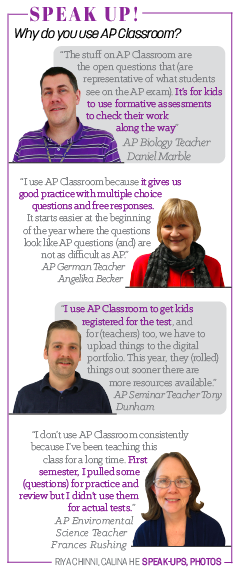
Finding up-to-date and accurate practice for AP exams has always been a gamble. Review books from test prep companies claim to provide all the practice necessary for success. In reality, the questions included in these books are not always reflective of the level of difficulty of AP exams. In 2018, the College Board announced it would unveil a bank of over 15,000 questions for all AP courses on Aug. 1, 2019 through AP Classroom. I was excited. However, AP Classroom has not lived up to my expectations—and this isn’t entirely the College Board’s fault.
AP Classroom consists of multiple-choice and free-response progress checks which can only be unlocked by teachers. Although AP Classroom resources have been available since August, only one of my AP teachers has unlocked resources continuously and assigned these checks as homework.

AP Classroom gives all students an opportunity to access valuable resources. While College Board has past FRQs out on the website, it only has decade-old multiple-choice practice. However, during the past decade, many AP courses underwent redesigns, such as AP Physics, or were created like AP Computer Science Principles. Without an official source of up-to-datepractice tests, students are often forced to turn to test prep companies’ books, which can sometimes be costly. Since many students at this school take more than one AP course, the cost can quickly pile up. By actively using AP Classroom, teachers could help students save money and time spent to find practice.
Unlocking resources at the end of a semester or year is not an effective solution either. Almost all AP courses at this school give students AP-style tests throughout the year. A student can know the content well, but this may not be sufficient for tackling AP-style questions. Doing these questions helps bridge the gap between the calculation-style problems in our textbook and the AP multiple choice we could see on assessments. In addition, AP Classroom classifies questions by unit and skill, which can help students pinpoint what areas they need to focus on the most. It is not an isolated effort by the College Board either; AP coordinators and teachers have collaborated to create these questions which ensures their effectiveness in the classroom.
The College Board has met schools halfway by creating AP Classroom. It is up to teachers to meet them in the middle by experimenting with the possibilities these resources provide. AP Classroom may be a work in progress but that is all the more reason for teachers to step up so the College Board can continue to improve with feedback.
The views in this column do not necessarily reflect the views of the HiLite staff. Reach Aditi Kumar at akumar@hilite.org.
Learn more about AP Classroom here.

































![AI in films like "The Brutalist" is convenient, but shouldn’t take priority [opinion]](https://hilite.org/wp-content/uploads/2025/02/catherine-cover-1200x471.jpg)









































![Review: “The Immortal Soul Salvage Yard:” A criminally underrated poetry collection [MUSE]](https://hilite.org/wp-content/uploads/2025/03/71cju6TvqmL._AC_UF10001000_QL80_.jpg)
![Review: "Dog Man" is Unapologetically Chaotic [MUSE]](https://hilite.org/wp-content/uploads/2025/03/dogman-1200x700.jpg)
![Review: "Ne Zha 2": The WeChat family reunion I didn’t know I needed [MUSE]](https://hilite.org/wp-content/uploads/2025/03/unnamed-4.png)
![Review in Print: Maripaz Villar brings a delightfully unique style to the world of WEBTOON [MUSE]](https://hilite.org/wp-content/uploads/2023/12/maripazcover-1200x960.jpg)
![Review: “The Sword of Kaigen” is a masterpiece [MUSE]](https://hilite.org/wp-content/uploads/2023/11/Screenshot-2023-11-26-201051.png)
![Review: Gateron Oil Kings, great linear switches, okay price [MUSE]](https://hilite.org/wp-content/uploads/2023/11/Screenshot-2023-11-26-200553.png)
![Review: “A Haunting in Venice” is a significant improvement from other Agatha Christie adaptations [MUSE]](https://hilite.org/wp-content/uploads/2023/11/e7ee2938a6d422669771bce6d8088521.jpg)
![Review: A Thanksgiving story from elementary school, still just as interesting [MUSE]](https://hilite.org/wp-content/uploads/2023/11/Screenshot-2023-11-26-195514-987x1200.png)
![Review: "When I Fly Towards You", cute, uplifting youth drama [MUSE]](https://hilite.org/wp-content/uploads/2023/09/When-I-Fly-Towards-You-Chinese-drama.png)
![Postcards from Muse: Hawaii Travel Diary [MUSE]](https://hilite.org/wp-content/uploads/2023/09/My-project-1-1200x1200.jpg)
![Review: "Ladybug & Cat Noir: The Movie," departure from original show [MUSE]](https://hilite.org/wp-content/uploads/2023/09/Ladybug__Cat_Noir_-_The_Movie_poster.jpg)
![Review in Print: "Hidden Love" is the cute, uplifting drama everyone needs [MUSE]](https://hilite.org/wp-content/uploads/2023/09/hiddenlovecover-e1693597208225-1030x1200.png)
![Review in Print: "Heartstopper" is the heartwarming queer romance we all need [MUSE]](https://hilite.org/wp-content/uploads/2023/08/museheartstoppercover-1200x654.png)



